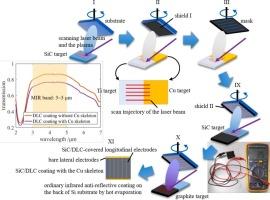Synthesis of the infrared transparent and conductive DLC coating based on PLD
IF 3.4
3区 物理与天体物理
Q2 INSTRUMENTS & INSTRUMENTATION
引用次数: 0
Abstract
The diamond-like carbon (DLC) layer was deposited via pulsed laser deposition (PLD) to serve as an infrared anti-reflective and protective coating for the Si substrate, leveraging its low infrared absorption and high hardness. Concurrently, the Cu electrodes were grown with mask based on its excellent conductive property. A buffer-structure of SiC / gradient Ti-Cu-Ti layer / SiC layer was designed and prepared to address the severe mismatch interface between the Cu layer and Si substrate (or DLC layer), enhancing the adhesive strength of the transparent and conductive coating. The DLC coating with Cu skeleton exhibited an average transmission of 75.2 % in the wavelength range of 3–5 μm and a square resistance of 2.7 Ω/sq, showing a relatively high figure of merit. And this coating beard the vertical force of 2.74 N/cm from the scotch tape according to National Military Standard of ‘General Specifications for Optical films (GJB 2485–95)’. This work prioritized simultaneous MIR infrared transparency and conductivity along with protective function, whereas conventional materials like ITO and Ag grid optimized visible/near-IR performance or flexibility, therefore, a direct comparison with them was challenging due to the divergent design priorities.

基于PLD的红外透明导电DLC涂层的合成
采用脉冲激光沉积(PLD)技术制备类金刚石(DLC)层,利用其低红外吸收和高硬度作为Si衬底的红外抗反射和保护涂层。同时,利用其优异的导电性能,用掩膜生长铜电极。设计并制备了SiC /梯度Ti-Cu-Ti层/ SiC层的缓冲结构,解决了Cu层与Si衬底(或DLC层)界面严重失配的问题,提高了透明导电涂层的粘接强度。在3 ~ 5 μm波长范围内,Cu骨架DLC涂层的平均透射率为75.2%,平方电阻为2.7 Ω/sq,具有较高的性能。根据国家军用标准《光学薄膜通用规范(GJB 2485-95)》,该涂层承受透明胶带的垂直力为2.74 N/cm。这项工作优先考虑同时具有MIR红外透明度和导电性以及保护功能,而ITO和Ag网格等传统材料优化了可见/近红外性能或灵活性,因此,由于设计优先级不同,与它们进行直接比较具有挑战性。
本文章由计算机程序翻译,如有差异,请以英文原文为准。
求助全文
约1分钟内获得全文
求助全文
来源期刊
CiteScore
5.70
自引率
12.10%
发文量
400
审稿时长
67 days
期刊介绍:
The Journal covers the entire field of infrared physics and technology: theory, experiment, application, devices and instrumentation. Infrared'' is defined as covering the near, mid and far infrared (terahertz) regions from 0.75um (750nm) to 1mm (300GHz.) Submissions in the 300GHz to 100GHz region may be accepted at the editors discretion if their content is relevant to shorter wavelengths. Submissions must be primarily concerned with and directly relevant to this spectral region.
Its core topics can be summarized as the generation, propagation and detection, of infrared radiation; the associated optics, materials and devices; and its use in all fields of science, industry, engineering and medicine.
Infrared techniques occur in many different fields, notably spectroscopy and interferometry; material characterization and processing; atmospheric physics, astronomy and space research. Scientific aspects include lasers, quantum optics, quantum electronics, image processing and semiconductor physics. Some important applications are medical diagnostics and treatment, industrial inspection and environmental monitoring.

 求助内容:
求助内容: 应助结果提醒方式:
应助结果提醒方式:


